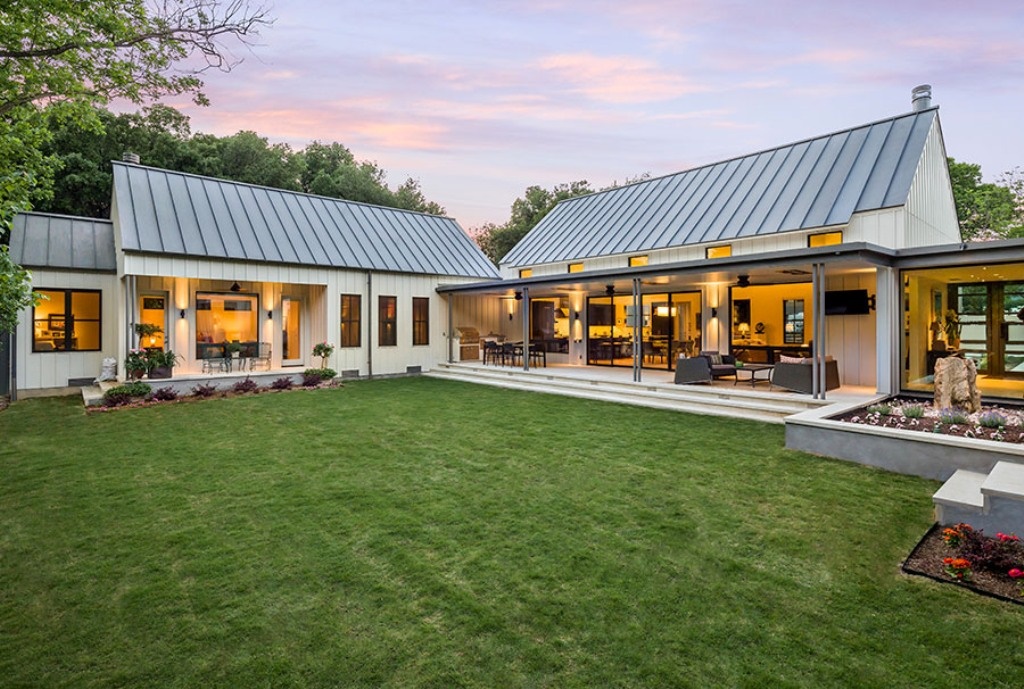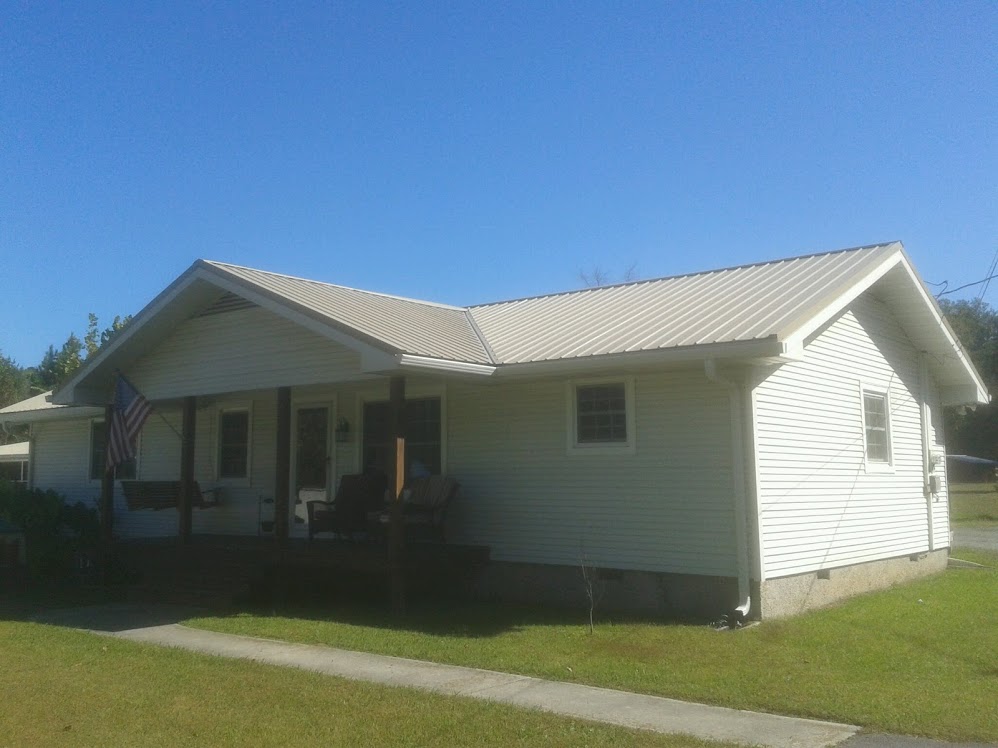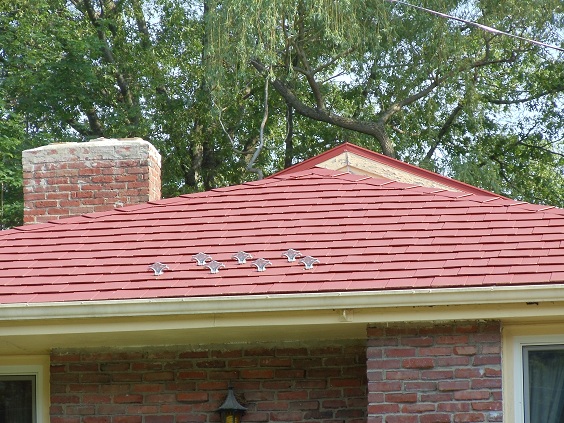Metal roofs are becoming increasingly popular with many savvy homeowners and it’s not hard to see why; compared to the more traditional approaches like asphalt shingles and cedar shingles and shakes, metal offers many important advantages including a significantly longer lifespan, low maintenance, excellent durability, and superior energy efficiency.
Cost:
On average, you can expect to pay between $10.50 to $20.50 per square foot to install a metal roofing system on a typical residential house. For example, an average-sized single-story house with a fairly simple roof shape measuring about 2,000 sq. ft. or 20 squares could cost anywhere from $21,000 to $41,000 for the installation of a high-end metal roofing system such as stamped metal shingles or tiles, or standing seam.
 Asphalt Shingles
Asphalt Shingles
$8,500 Average Cost |
 Metal Roof
Metal Roof
$15,500 Average Cost |
 Flat Roof Membrane
Flat Roof Membrane
$11,500 Average Cost |
|
|
||
Note: We have received numerous reports from homeowners in California and other high cost of living coastal areas that high-end residential standing seam metal roofing systems were selling for $18.50 to $22.50 per sq.ft., especially in the fire-prone areas in California during past summer. This would be above the national average price range stated in this guide.
Also note that real estate prices have increased by double digits across the US and expensive coastal areas are no exception. With the increase in property values, the demand for remodeling services has surged, thus driving up the prices for high-end exterior remodeling upgrades like metal roofing.
The price range provided in this guide contains an 80% range of all residential metal roofs installed on homes nationally. That said, there will be outliers to the national average, especially in the high cost of living coastal areas such as part of Southern (Los Angeles) and Northern California (San Jose, San Francisco Bay area), Oregon, and parts of the greater Seattle, WA.
Note on the wider pricing range for different metal roofing profiles:
Given a wide range of various metal roofing systems such as corrugated metal panels, stamped and stone-coated metal tiles, and standing seam, you can expect to pay anywhere from $5.50 to $25.50 per sq. ft. to install a new metal roof on your home or commercial property. This is a rather wide pricing range, so here is a more detailed breakdown:
- Corrugated Steel and Ribbed “R” Metal Panels with Exposed Fasteners (G-60 and G-90 steel): $5.50 to $8.50 per sq. ft. or $550 to $850 per square (100 square feet) fully installed.
- Metal Shingles and Shakes (G-90 steel or aluminum): $10.50 to $16.50 per sq. ft. or $1,050 to $1,650 per square (100 square feet) fully installed.
- Stone-coated Steel Shingles and Tiles (Galvalume or G-90 steel): $10.50 to $15.50 per sq. ft. or $1,050 to $1,550 per square (100 square feet) fully installed.
- Standing Seam (Galvalume, G-90 steel, or aluminum): $12.50 to $18.50 per sq. ft. or $1,000 to $1,850 per square (100 square feet) fully installed.
- Zinc Shingles and Zinc Standing Seam: $12.50 to $20.50 per sq. ft. or $1,250 to $2,050 per square (100 square feet) fully installed.
- Copper Shingles and Copper Standing Seam: $15.50 to $25.50 per sq. ft. or $1,550 to $2,550 per square (100 square feet) fully installed.
Metal
Flat
$15,500
$11,500
Thus, the very low-end of the above pricing range is appropriate for most low-end, G-60 corrugated and ribbed metal roofs with exposed fasteners, while the higher cost is typically associated with metal shingles and stone-coated steel tiles, and standing seam metal roofs. — The prices tend to increase in that order.
Note: A metal shingles roof is one of the most common residential metal roofing profiles, second only to a slightly pricier standing seam. Most metal shingles profiles are available as ether G-90 galvanized steel shingles or aluminum shingles. Companies like Tamko Metal Works, EDCO, Future Roof, PermaLock, and Classic are some of the most prominent residential metal shingles, shakes, and tiles manufacturers on the market.

Installation cost factors: Your home’s location, roof pitch, number of stories, and overall complexity of the job, including any roof pitch or level changes, dormers, chimneys and skylights, number of layers of old shingles to be removed, and contractor choice will also have a major effect on your total cost installed.
Note: most contractors price their roofs on a per square basis, where one square is a 10 by 10 square feet area or 100 square feet. Thus, the cost in square terms could range from $10.50 to $20.50 per square of metal roofing installed across the US, based on the 80% range of all residential jobs.
Did you know? Standing seam is by far the most popular and expensive metal roofing option, typically costing between $12.50 to $20.50 per sq. ft. or $1,250 to $2,050 per square (100 sq. ft.) installed. Standing seam panels are available in Kynar 500 coated painted aluminum, G-90 galvanized steel, Galvalume steel, zinc, copper, and stainless steel.
For comparison: most asphalt shingle roofs will cost anywhere from $5.50 to $8.50 per sq. ft. or $550 to $850 per square (100 sq. ft.) installed, depending on the material choice, roof complexity, installer’s credentials, your geographic area, time of the year, and so forth.
Did you know? A roof designed to reflect solar radiant heat (CRRC or Energy Star rated) can help drastically reduce your cooling costs and HVAC demand load during peak hours in the summer.
Metal Roof vs. Asphalt Shingles:
It’s a well-known fact that metal roofs have always been somewhat expensive compared to the far more widespread composition (asphalt) shingle roofs. — This is mostly due to a much higher base cost of both, materials, and professional labor.
The cost of professional labor is a major factor affecting the cost of metal roofing, with an often-tedious installation process that requires a high degree of precision, and hence well-trained installers, with specialized tools and equipment. The difference in cost can also be partially attributed to a simple supply and demand.
The Cost of Materials
The answer can be anywhere from $1.50-$2.00 per square foot for a low-end G-60 (galvanized 29-gauge steel) to mid-range G-90 (26-gauge galvanized steel) corrugated metal panels (with exposed fasteners), finished with a lower-grade (cheaper) acrylic paint, up to about $4.50-$6.50 per square foot for the high-end aluminum or Galvalume (24-gauge zinc and aluminum coated steel) standing seam metal panels featuring concealed fasteners.
A mid-range, G-90 galvanized steel shingles roofing system, such as Tamko Metal Works, Edco Metals, or Future Roof, will cost about double the cost of asphalt shingles or higher, when fully installed.
The cost of materials alone would be about $4.00 to $5.50 per square foot, plus the cost of underlayment (about $100 to $150 per roll for 400 sq.ft. of breathable synthetic underlayment). Fully installed, such a system may cost anywhere from $9.50 to $15.50 per square foot for an average roof.
For example, an average-sized single-story house with a fairly simple roof shape measuring about 1,700 sq. ft. or 17 squares could cost anywhere from $14,450 to $26,350 for the installation of a metal shingles roof.
Then there are the “more-exotic” systems such as stainless steel millennium tiles that will cost you about $10.00 per square foot for materials, or as much as $16.00 to $25.00 when fully installed. — This cost, by the way, is comparable to the cost of premium copper roofing.
Making Sense of the Confusion
The main thing to realize with metal roofing, is that your price will depend a great deal on the exact type of a roof you want.
“Metal roofing” is a rather broad term that encompasses many different materials and systems ranging from the basic G-60 steel (low-end corrugated metal panels) and G-90 galvanized steel (residential grade 26- 24-gauge steel) to an even better quality Galvalume steel, aluminum, zinc, copper, titanium, and stainless steel.
It is helpful to know that G-60 corrugated steel is by far one of the least expensive options, while zinc, copper, titanium, and stainless steel are at a significantly higher end of the spectrum. However, the precise nature and overall complexity of the installation will also make a significant difference to the final cost.
With a true abundance of materials and systems, most homeowners will opt for either metal shingles, stone-coated steel tiles (especially in Florida), and standing seam metal roofs.
Metal shingles can be made from either G-90 (galvanized) steel, or aluminum, while standing seam metal panels can be roll-formed from Galvalume steel, G-90 galvanized steel, aluminum, zinc, and copper. Most residential-grade metal roofs are painted with a high-end paint finish, such as Kynar 500 / Hylar 5000, or better.
Most metal shingle roofs will cost anywhere from $10.50 per square foot or $1,050.00 per square (100 sq. ft.) and up for materials and labor, while standing seam metal roofs can easily cost more than $1,650.00 per square due to the higher cost of materials, and often a more tedious and involved installation process, especially on roofs with dormers, peaks, and, valleys.
System Installation Difficulty and Labor Costs Considerations
As a homeowner, it is vital that you look at the total cost of the installation rather than just the price of the raw materials. Labor costs can easily make up a larger percentage of the total cost than the metal itself. This is not to say that metal roofs are always expensive to install.
On the contrary, if you decide to install a new metal roofing system over the existing roof, the costs can be quite manageable.
However, a more thorough job that involves stripping off the old roof completely, will definitely tip the scales towards a higher overall price tag for the job.
Note that taking a “big picture” look at the costs also means thinking about the overall longevity and energy efficiency of a newly installed roofing system.
Cost Over Time
Like many modifications to a home, metal roofing should be viewed as an investment in a long-lasting and energy efficient roof to protect your home from the elements. Although the initial cost may seem quite high, it is important to remember that these roofs can easily last for many decades. The better materials and design such as standing seam may well last for as long as the house itself.
It is also important to take into account the extra energy efficiency a metal roof provides. Since less heat can escape in cold weather and less can get inside the house during the summer, your heating and air conditioning bills are going to end up being less costly and far more reasonable as a result of having a properly installed metal roof, with a well-insulated and properly-ventilated attic space.
Over the next 10 to 20 years, this by itself may easily help recoup the cost of the initial expenditure, while also increasing the value and greatly enhancing the curb appeal of your home.
Did you know? In addition to solar reflectance, there is also the so-called thermal emissivity, which speaks to how quickly a roof can cool off by emitting away any accumulated heat, such as after the sunset. — As you may have guessed, asphalt roofs normally take a lot longer to cool off at night, after a hot summer day.
Both, solar reflectance, and thermal emissivity will help lower your AC energy expenditures and and boost your home’s energy efficiency.
Pro Tip: If you want an energy efficient roof, look for CRRC and/or Energy Star rated colors when choosing a color for your new metal roof.
Need a Pro? Check out Prices from Local Roofers:
Enter your zip code:
Pros and Cons
Pros:
- Durability: Metal roofs can last for 50 years or more, compared to traditional roofing materials like asphalt shingles that typically last for 20-25 years. Metal roofing materials are resistant to weather conditions like high winds, heavy rain, and snow.
- Energy Efficiency: Metal roofs can help reduce energy costs because they reflect sunlight instead of absorbing it. This can help keep your home cooler in the summer and reduce your reliance and wear and tear on the air con system.
- Low Maintenance: Metal roofs require very little maintenance compared to other roofing materials. They are resistant to moss, mildew, and algae growth, and can be easily cleaned with a hose or pressure washer.
- Aesthetic Appeal: Metal roofing comes in a variety of colors and styles to match the look of any home. It can add a modern or industrial look to your home, or blend in with a more traditional style.
- Ice Dam Prevention: Metal roofs shed snow and ice, thus helping prevent ice dams from forming on the roof. However, it is still recommended to make sure the roof attic space is properly insulated and ventilated to ensure a durable and long lasting roof.
- Solar Ready: If going solar is something you are considering in the future, a standing seam metal roof is an ideal companion for solar panels. No need to drill holes in your roof, as solar panels can be mounted atop the raised seams with the help of S-5 brackets.
- Fire Resistance: Metal roofs are non-combustible and have a Class A fire rating, making them a safer option than some other roofing materials.
- Environmentally Friendly: Metal roofing materials are often made from recycled materials and can be fully recycled at the end of their lifespan, making them a more sustainable option.
- Increased Home Value: Metal roofs can increase the value of your home, as they are considered a premium roofing option and can be a selling point for potential buyers.
Cons:
- Cost: Metal roofing can be more expensive upfront compared to other roofing materials like asphalt shingles. However, the long lifespan of metal roofs can make them a more cost-effective option in the long run. A lifecycle cost of metal roofs can actually be lower than asphalt.
- Possible Noise: Metal roofs can be mildly noisy during heavy rain or hailstorms. However, proper insulation and roof deck sheathing will help reduce the noise levels.
- Installation: Installing a metal roof can be more difficult and time-consuming compared to other roofing materials. It requires specialized knowledge and tools to install properly, which is why residential-grade metal roofs cost more to install compared to asphalt shingles.
- Oil Canning: Some standing seam metal panels can be subject to “oil canning” effects, especially when the panels are wide enough and long enough. However, a mid-panel rib-stiffening technique will help prevent the oil canning. That said oil canning is a purely aesthetic phenomenon.
- Denting: Metal roofs can be somewhat prone to denting if hit by heavy objects like falling branches or hailstones. However, some metal roofing materials like stone coated steel tiles are more resistant to denting than others. In fact, stone coated steel tiles are the only roofing material that is warrantied against hail impact damage by manufacturers.
- Expansion and Contraction: Metal roofing materials can expand and contract with temperature changes, which can cause fasteners to loosen over time. Proper installation and maintenance can help prevent this issue.
- Installation Issues: Installing metal roofs on complex roof structures such as roofs with Victorian style towers, or highly cut-up roofs with many skylights or vents can be more challenging and time-consuming.
- Possible Rust and Corrosion Issues: Metal roofs can be susceptible to rust and corrosion over time, especially in areas with high humidity or salty air. Choosing the right metal roofing material with a Kynar 500 paint finish, and the right metal allow for the environment, and properly maintaining it can help prevent this issue.
When is Asphalt a Better Option than Metal?
Yes, there are some instances when asphalt shingles may be a better option than metal roofing:
- Budget: Asphalt shingles are generally less expensive than metal roofing materials, making them a better option for homeowners on a tight budget.
- Aesthetics: Some homeowners prefer the look of asphalt shingles over metal roofing. Asphalt shingles come in a wide range of colors and styles, and can be designed to match the look of any home.
- Installation: Asphalt shingles can be installed quickly and easily, even on complex roof structures. Metal roofing installation can be more challenging, especially on roofs with many skylights, vents, or other features.
- Repairability: Asphalt shingles can be easily repaired or replaced in small sections, whereas metal roofing often requires replacing larger sections of the roof.
- Not your Forever Home: Metal roofs may not be the best option, economically, if you are not planning to stay in your home for more than 5 years. While metal roofs maintain their value and curb appeal extremely well, if you plan on moving in just a few years, then mid-range architectural shingles will provide a better overall cost to value return upon resale.
Ultimately, the decision between asphalt shingles and metal roofing will depend on factors like budget, aesthetics, and climate. It’s important to weigh the pros and cons of each option carefully before making a decision.
In Conclusion:
As we have explained, it is hard to hone in on the exact cost of a new metal roof without knowing about your specific situation and plans.
While making sense of the wide range of prices can seem daunting, at first, simply narrowing down your options can clarify things in no time.
Even if you opt to go for an expensive solution such as stripping your existing roof and replacing it with aluminum or another high-quality material, you stand to gain a great deal in terms of having a low roof maintenance, high energy-efficiency, and confidence of knowing that your home is protected by a durable and long-lasting roofing system that is also kind to the environment and will likely last for as long as the property it protects.

 See what local pros charge
See what local pros charge








